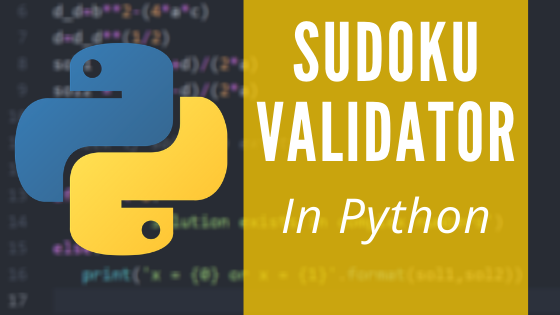In this article, we have built a program to find whether the given Sudoku Solution is valid or not, with the Python code.(Sudoku Validator using Python). Please install python 3.8 from the link given below to run this code.
https://www.python.org/downloads/
I prefer you to use atom text editor to type your code or to save the given code:
https://atom.io/
You can download the the Sudoku.py from GitHub using the given link:
Example Input:
123456789
234567891
345678912
456789123
567891234
678912345
789123456
891234567
912345678Output:
FalseRecommended:
Code:
try:a = input(),input(),input(),input(),input(),input(),input(),input(),input()
except:print('You must enter a 9x9 input')
def vert(a,num):
x=[]
for i in range(9):
x+=(a[i][num])
return ''.join(x)
b=[]
for i in range(9): b+=list(vert(a,i))+[' ']
b = ''.join(b).split()
box1,box2,box3,box4,box5,box6,box7,box8,box9=[],[],[],[],[],[],[],[],[]
for i in range(3):box1+=(a[i][:3])
box1=''.join(box1)
for i in range(3,6):box2+=(a[i][:3])
box2=''.join(box2)
for i in range(6,9):box3+=(a[i][:3])
box3=''.join(box3)
for i in range(3):box4+=(a[i][3:6])
box4=''.join(box4)
for i in range(3,6):box5+=(a[i][3:6])
box5=''.join(box5)
for i in range(6,9):box6+=(a[i][3:6])
box6=''.join(box6)
for i in range(3):box7+=(a[i][6:])
box7=''.join(box7)
for i in range(3,6):box8+=(a[i][6:])
box8=''.join(box8)
for i in range(6,9):box9+=(a[i][6:])
box9=''.join(box9)
hc,vc,bc = 0,0,0
def horcheck(a):
hc= 0
for i in a:
for j in i:
if i.count(j)>1:
hc = 1
return False
break
if hc==1:break
if hc==0:return True
def vercheck(a):
vc= 0
for i in a:
for j in i:
if i.count(j)>1:
vc = 1
return False
break
if vc==1:break
if vc==0:return True
def boxcheck(a,b,c,d,e,f,g,h,j):
bc =0
for i in a:
if a.count(i)>1:
bc =1
return False
if bc ==0:
for i in b:
if b.count(i)>1:
bc =1
return False
if bc ==0:
for i in c:
if c.count(i)>1:
bc =1
return False
if bc ==0:
for i in d:
if d.count(i)>1:
bc =1
return False
if bc ==0:
for i in e:
if e.count(i)>1:
bc =1
return False
if bc ==0:
for i in f:
if f.count(i)>1:
bc =1
return False
if bc ==0:
for i in g:
if g.count(i)>1:
bc =1
return False
if bc ==0:
for i in h:
if h.count(i)>1:
bc =1
return False
if bc ==0:
for i in j:
if j.count(i)>1:
c =1
return False
if horcheck(a) and vercheck(b) and boxcheck(box1,box2,box3,box4,box5,box6,box7,box8,box9):
print(True)
else:
print(False)Recommended:
Code Explanation:
In this code, we get 9 inputs from the user, where each input has 9 characters.
At first we Try to get the inputs from the user, and if the user does not enter exactly 9 inputs, the Except statement prints out ‘You must enter a 9×9 input’.
Function vert():
Now in order to check whether the solution characters are vertically unique, we define a function called vert() that takes two parameters.
We store the vertical version of the input in the variable b.
Recommended:
Boxes:
We define variables that store the values of the bigger boxes that is usually seen 3×3 in the game. And since we have 9 big boxes, we define 9 variables (box1, box2, box3, box4, box5, box6, box7, box8, box9)

Function horcheck(), vercheck() and boxcheck():
We define another 3 functions horcheck(), vercheck and boxcheck() that checks the character uniqueness horizontally, vertically and with each box respectively.
The functions return True if all the characters are unique horizontally, vertically and with respect to each box, and False is not.
Recommended:
And now, our code works perfectly fine.
Conclusion:
The above article explains the Sudoku Validator using python coding. If you want to download the code from GitHub, click here. If you have any questions or feedback on this, feel free to post in the comments section below.

